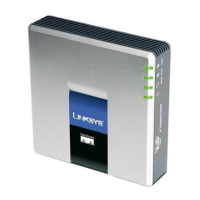Linksys Voice System Administration Guide 72
Call Transfer Support on SPA9000
Configuring Phone Lines and Calling Routing Behavior
Call Transfer Support on SPA9000
• ”Call Forward Bridge Mode,” on page 72
• ”Call Transfer Bridge Mode,” on page 72
Call Forward Bridge Mode
The normal way of performing the call forwarding operation is for the SPA9000 to send a (blind)
SIP REFER to the calling device to let it contact the target number directly. It then drops out of
the call completely. This requires the calling device to understand the SIP signaling involved
and the operation permitted by the underlying service provider. The SPA400 cannot handle this
operation.
With bridging, the SPA9000 maintains two separate call legs throughout the call: one with the
caller and one with the call forward target. The two call peers connect only with the SPA9000,
while the SPA9000 acts as a proxy for the RTP packets exchanged between the two parties.
On the Voice > Line N page, Proxy and Registration section, the CWFD Bridge Mode field has two
possible values:
• none—Do not bridge forwarded calls (use the normal REFER method)
• all—Bridge all forwarded calls
Call Transfer Bridge Mode
The normal way of performing this operation is for the SPA9000 to send a SIP REFER method to
the calling device to let it contact the transfer target directly. The SPA9000 then drops out of the
call completely. This requires the calling device (the transferee) and the target device to
understand the SIP signaling involved and the operation permitted by the underlying service
providers. Note that the call legs with transferee and the transfer target might be with different
ITSP. The SPA400, for instance, cannot handle this operation.
With bridging, the SPA9000 maintains two separate call legs throughout the call: one with the
transferred call and one with the transfer target. The two call peers connect only with the
SPA9000, while the SPA9000 acts as a proxy for the RTP packets exchanged between the two
parties.
On the Voice > Line N page, Proxy and Registration section, the XFER Bridge Mode field has three
possible values:
• none —Do not bridge call transfer (use the normal REFER method)
• all —Bridge all call transfer
• all except same line—Bridge call transfer only if it is between two different line
interfaces

